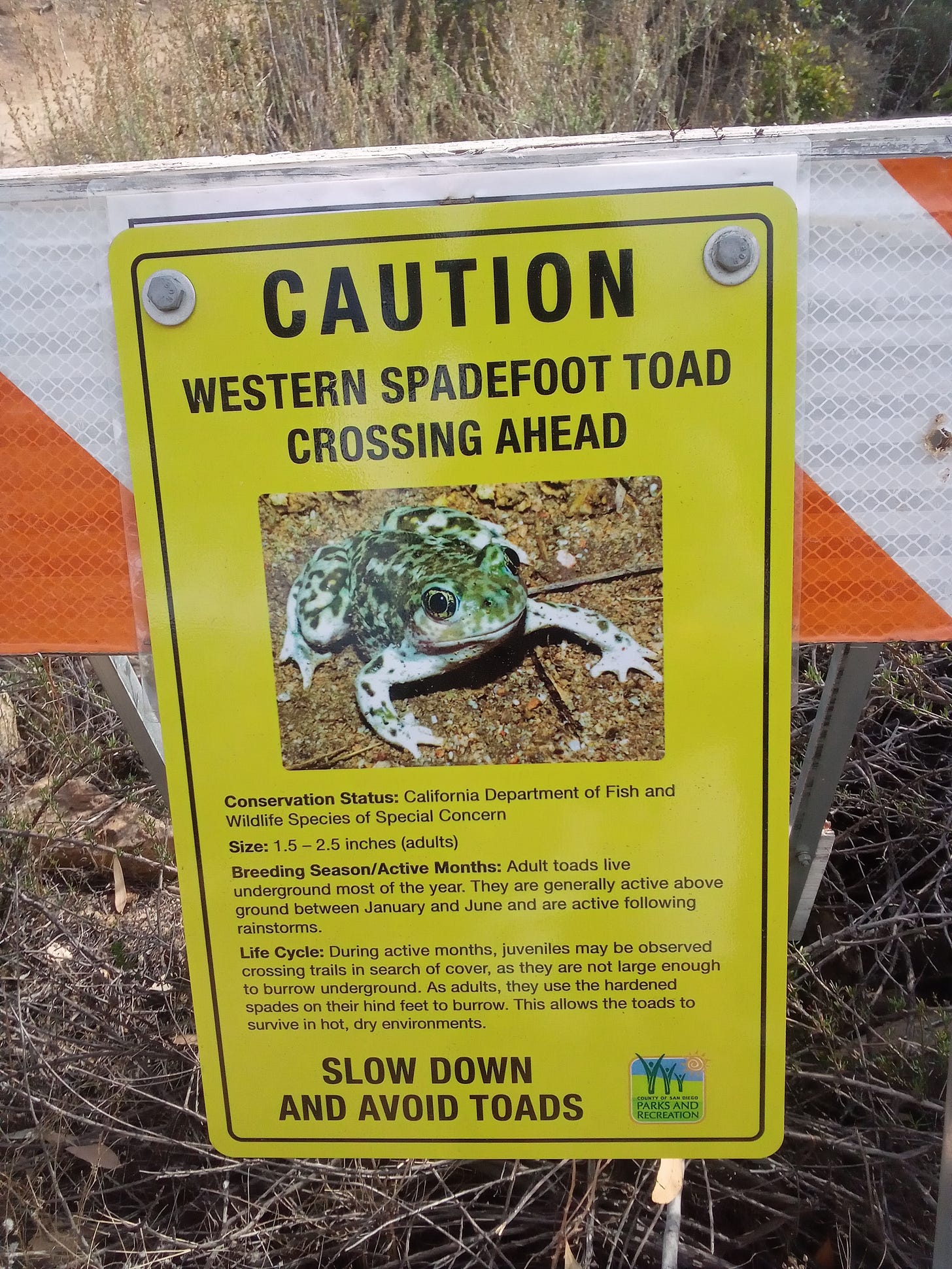E-MTB = Environmental Mountain Biking (?)
Western Spadefoot Toad Crossing, Fully Rigid - 2/15/21
E-MTB = Environmental Mountain Biking (?)
How many times have we been out on the trail and stopped to breathe, have a bite to eat, wait for someone to catch up and looked around at the landscape and thought: it is beautiful here. Countless times, I’m sure. In those moments we recognize the natural beauty that surrounds us, thankful for its existence and that we are able to ride bikes amidst it.
The ridgeline across the way silhouetted in the waning light of evening.
Ocotillos bloom fire red in the desert.
Deer stand stock still in the meadow.
Water runs over rocks and plunges to a pool below.
Birds sing songs and forage for food.
We see it. When we are out there, we feel it. It is not possible to be a mountain biker and not have some connection to Earth’s rhythms. Maybe, though, we do not always admit it when hanging out with riding friends. The question is, why not?
Who amongst us wants to see our favorite trail systems turned into cookie cutter housing? How about an oil and gas development site? Do we want to ride through landscapes that are not protected and managed with not only us and other trail users in mind, but also with bears and trees and fishes and bees, too?
The other week while riding, I came across a sign at a trail head that reminded me of all of this. Western Spadefoot Toad Crossing Ahead. Slow Down and Avoid Toads. There was no doubt about it; I was going to go slow and hope to see one.
They are found from California’s Central Valley south to northern Baja, from sea level on up to near 5000 feet in the coastal ranges. They are most abundant in grasslands, but also live in pine-oak forests and are sometimes dependent on vernal pools for survival/propagation. They eat worms and insects and are eaten by birds and a few mammals.
I did not see one. Over the years, though, I have seen horned toads. I once got off my bike and crawled around to find one in the chaparral. I did. Also, stopping to listen to a chorus of frogs puts a smile on my face.
Did you know that frogs and toads are indicator species? Basically, they are super sensitive to changes in the environment. In a nutshell, they often provide insight to scientists on how healthy and well-functioning an ecosystem is. Think of it this way: if you see frogs or toads wherever you are that have obvious deformities, e.g. an extra leg, there is likely something wrong with the local environmental conditions.
Who cares? Well, I do. I am an Environmentalist and a Mountain Biker. Of course, there are varying kinds of environmentalism and extremes to how people may define environmentalism and environmentalist. It has been debated for decades, as an academic construct. It has been pulled apart and fought over in public land management meetings, as a matter of practicality. Things get real, real fast, when an endangered species is found where we recreate and shuts down our access to land.
Who cares? I think you do, too. I’m not convinced that one mountain biker is not to some degree an environmentalist. Again, we need to remind ourselves, there is not one definition as to what it means to be an environmentalist. People will tell you differently on that; they’ll try to convince you otherwise. Whoa to those ways, I say. There are more boxes than one. Besides that, I don’t like such boxes.
The question is this: what kind of environmentalist mountain biker are you? Let that roll around your head like pebbles on the river bottom or thunder clouds over the mountain pass the next time you’re out riding. I’m willing to bet you’ll find some degree of wanting to protect and manage the land you’re riding on.
Then what?
It could be that the challenge is talking about it with fellow environmentalist mountain bikers, trying to understand the varying degrees of “environmental” … and then the hikers, trail runners, equestrians, ORVers, backpackers, dog walkers … and not to forget the mountain bikers who think environmentalism is a bad word and that all environmentalists are opposed to their riding experience, which is simply …
… not true.








Timely article James. With the recent MTB boom there are lots of newbies on the trails that have no idea what we’ve lost, or could lose. For most, all they know is what they see in the adds and on YouTube. Which usually involves tearing down a trail and catching big air. So when you write “who cares”, that’s the feeling I get from them. Hate to sound so negative, it’s generally not my nature. I try to follow my parents advice and leave a place better than I found it. Wish more people did the same.
Nice article. You might find this video of interest. Dillon O is the exec director of Sage Trail Alliance in Santa Barbara. He is among a new wave of younger trail advocates/enviromentalists.
https://youtu.be/uReKZL5HvL8